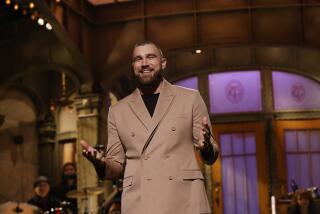Some âDot-Comsâ Fumble Efforts to Score in Ad Game
Sundayâs Super Bowl game wreaked havoc on viewers who were trying to keep score of how many âdot-comâ marketers made appearances--and what those online companies had to say.
Did ABCâs broadcast of the St. Louis Ramsâ last-minute victory over the Tennessee Titans feature 16 or 17 online companies? Will Lifeminders.com be penalized by viewers for the spot that billed itself as âthe worst commercialâ to run during the highly watched game?
Answers to questions generated by Dot-com, er, Super Bowl XXXIV wonât arrive until later today, when market research firms crunch television ratings data and online traffic related to the Internet-heavy advertising avalanche. Early returns from a group of USC graduate students who watched Sundayâs commercials as part of a sports marketing class suggest that while many spots entertained, not all delivered a clear message.
The students were confused by a computer-generated spot from money manager John Nuveen & Co. that showed paralyzed actor Christopher Reeve walking down an aisle. A WebMD.com ad featuring boxer Muhammad Ali grabbed the groupâs attention, but even after the ad ran a second time, the six MBA students werenât sure what product was being pitched.
âWe see the famous faces up there, and we pay attention and watch it; but when itâs over, all I remember is Muhammad Ali,â said Lida Jennings of Tustin. âThe ad spent too much time entertaining us, and not enough time giving us their message.â
In contrast, students applauded a Charles Schwab commercial that drew attention by showing recently retired sports figures--including basketball player Charles Barkley and football coach Mike Ditka--in unlikely retirement settings.
âThe ad told you exactly what they do for retirement planning,â said Gerard Artavia, who is planning on a career in sports marketing. âThe famous faces made us watch, but I also feel that I know something about what the company does.â
E-Trade, an online stock trading company, also won praise for blending humor with a message. âE-Trade has been all over this broadcast,â said Kiki Oquendo, a civil engineer who is pursuing an MBA at USC. âThey aimed it at a broad selection of people and didnât try to use terms that people might not understand.â
Advertisers on Sunday offered something for everyone. Male-oriented ads were plentiful--Anheuser-Busch showed guys bonding with their favorite brew, while a mountain dude chased down a cheetah to retrieve a can of Mountain Dew. Oxygen Media promoted its women-oriented Web site and cable network. Pets.com pitched products for Kitty and Spot. And Shaquille OâNeal joined Regis Philbin in celebrating Mickey Mouse.
Advertisers wonât know until later today how the broadcast fared from a ratings standpoint. St. Louis ran up a 16-0 lead but was lucky to come away with a 23-16 win after the Titans went on a second-half scoring spree. Tight games usually produce better ratings--as was the case in 1982 when the San Francisco 49ers held on to beat the Cincinnati Bengals in Super Bowl XVI.
The exciting finish, though, might not have been enough to overcome the lack of marquee players and the fact that the game featured teams from small media markets. Marketers also were eager to learn how well the Internet was integrated into the broadcast watched by an estimated 130 million people.
The rush of dot-com advertisers left some marketers wondering whether viewers would be able to absorb all of the Internet-related messages.
Last year, a handful of dot-coms--most notably Monster.com, an online classified service--scored big points with their Super Bowl commercials.
The online arena was far more crowded Sunday night. The USC group counted 17 Internet companies using commercials to promote their Web sites. ABC-TV and dozens of other sports-related Web sites asked fans to surf their Internet sites while watching the game on the tube.
ABCâs Web site experienced some second-half problems, forcing fans who were tracking the game online to reboot their machines. David Carter, a consultant who teaches sports marketing at USC, gave up trying to follow the game online and on the big screen.
âItâs too intrusive,â Carter said of the exercise in dual-tasking. âYou canât get involved in both of them at the same time.â
The Internetâs increasing role in advertising was evident by the migration of ads to online sites. Moments after the game ended, ads for E-Trade, NAPA Auto Parts and BMW of America were running on Yahoo Inc.âs Web portal.
Sundayâs ABC broadcast ran the gamut from Federal Expressâ beautifully photographed ad that used scenes from the 1939 film classic âThe Wizard of Ozâ to Lifeminders.comâs quirky spot, which boasted of being the broadcastâs worst commercial. USCâs grad students agreed--and argued that the companyâs $2-million commercial investment could have been better spent elsewhere.
The twentysomething students, who envision one day working for companies that might choose to advertise on future Super Bowl broadcasts, gave high marks to an ad from employee staffing firm Kforce.com, which included a veiled poke at competitor Monster.com. Britannica.comâs ad, which used a simple question-and-answer format, drew praise, as did the spots from competitors E-Trade and Schwab.
Agillion.comâs ad clearly baffled the group--minutes after it ran, students couldnât find the Web site because no one remembered how to spell the name. One bungled attempt led to a Web site owned by a newlywed couple.
âThereâs something to be said for simplicity, for getting your attention and delivering your message,â Artavia said.
Students turned thumbs down to Mountain Dew, 7-Up, Oldsmobile, Agillion.com, WebMD.com and MicroStrategy. The students split along gender lines when the Oxygen Media ad--which referred to Web site and cable channel that target women. Women loved the ad, but men were lukewarm.
Monster.com, which drew rave reviews for last yearâs commercials, wasnât as impressive this year, the students said.
More to Read
Go beyond the scoreboard
Get the latest on L.A.'s teams in the daily Sports Report newsletter.
You may occasionally receive promotional content from the Los Angeles Times.










